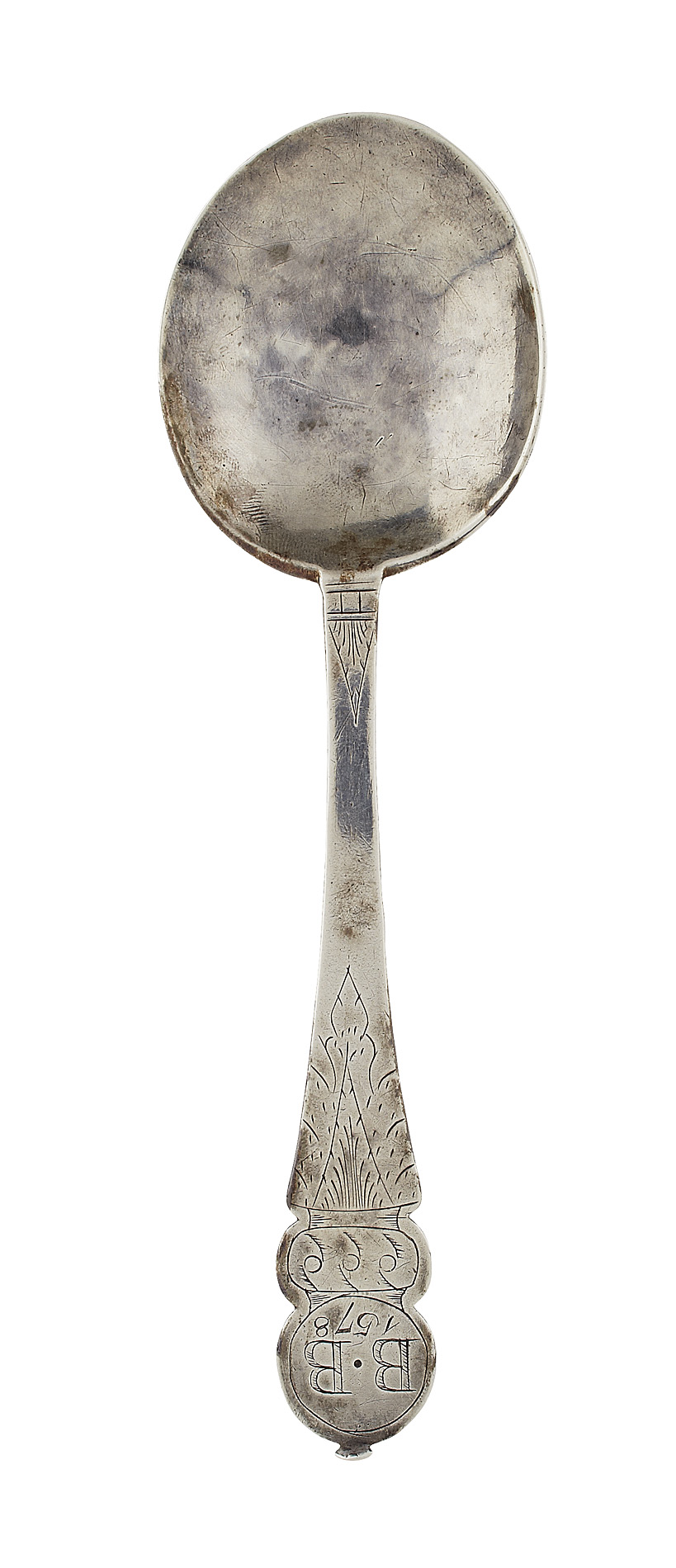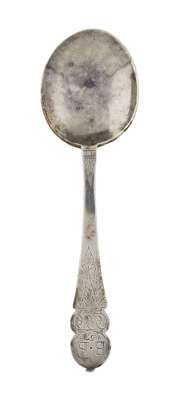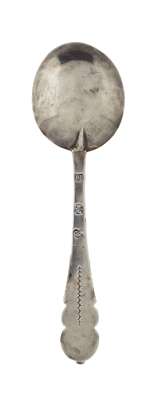
Lot 523

A rare Charles I Disc-end spoon








Auction: 14 August 2012 at 15:00 BST
Description
by Peter Neilson, Edinburgh 1648 - 1650 or 1655 - 1657, Deacon George Cleghorn, marked from bowl PN (conjoined), castle, GC, zig zag assay scrape, compressed finial above disc terminal engraved 'BB' with slightly later date '1575' bellow, the compressed lower cartouche with semi spiralled decoration, above large foliate decoration to stem, the join of stem and bowl with long V shaped foliate detail with horizontal and vertical decoration below
Dimensions
18.3cm long, 47g
Footnote
Notes: this spoon previously recorded in 1911 by Sir Charles Jackson is a major appearance on the Scottish silver market. Not only does this spoon match with another identical in the Mount Stuart Collection but adds further to our understanding of both spoons.
While most early Scottish spoon types follow closely known and comparable patterns, whether it is with English neighbours or further afield in main land Europe, the Disc end is without doubt the most unique to Scotland. The only strong comparable comes from a very small group of York made spoons known as the 'Death Head' group.
It has been commented that some mainland European spoons bear resemblances to the Disc Ends and while this is an influencing factor in many areas of Scottish silver work it does not seem to follow in this example. The main types often compared with the Disc Ends are Norwegian examples with flower head terminals. However this is not perhaps a true comparison as the terminals are not flat discs and are more often of shaped outlines following that of the flower head. Since no Scottish spoon has a figural finial or terminal this seems a very tenuous connection and not a credible one for comparison.
The York 'Death Head' group which closely follows the basic outlines of Scottish Disc Ends are similar in many respects but deviates noticeably within the date range, the York examples appears to start after the end of the disc end in Scotland, their date range being circa 1660 - 1670s. It is not only the date range which differentiates the two types but the decoration and original commission are extremely different. The York examples appear to have been made as either christening or memorial spoons, the Scottish being a standard pattern of its time.
The original commission for the Death Head spoons is still a little unclear, adding further to the mystery of the group. It is obvious they are only made for the female members of the Strickland family, either as christening or memoriam spoons but little else can be said.
The connection between these two very distinct groups of spoons is still a mystery and no real defining connection can be found. On the most basic of levels the Scottish Disc end gives the perfect canvas for the York design with the circular terminal offering space for the engraved skull / coat of arms and flat straight stem giving the space for mottos.
It can be safely assumed that the York examples were copied from an original, and earlier, Scottish spoon as the general points of compare are too similar for coincidence.
Rarely for such an early piece of Scottish silver the original owner of the engraved initials to the terminal are known. The original owner, Bessy Boyd coming from two important Glasgow families.
Bessy was daughter of Archbishop James Boyd of Glasgow, who was one of three Protestant Archbishops appointed by King James VI to Glasgow Cathedral. A memorial stained glass window (by Ballantine & Allan) of Archbishop James Boyd can be found in the north wall of Lower Church.
Archbishop Boyd was not the only important member of the clergy in the family, Bessy's brother Robert Boyd had a distinguished career in Scotland and France and held many important positions including professor at Vertuile and Saumur, Principal of Glasgow University, professor of Divinity at Edinburgh University and minister of Paisley Abbey.
Bessy was twice married - firstly to Patrick Maxwell, merchant in Glasgow, who was 3rd son of John Maxwell 4th of Auldhouse and related to the Maxwell's of Pollock House. Patrick died in 1623 and Bessy later married her cousin, also a Boyd.
The date of spoons and Patrick Maxwell's death mean these spoons must relate to Bessy's second marriage.
The close ties between Bessy and the Maxwell family are also seen upon her death as she was buried in the Maxwell family plot within the Glasgow Cathedral graveyard, beside her first husband Patrick.
The inscribed date to the terminal, interestingly obliterated on the Mount Stuart example, is obviously of a slightly later date but no obvious date of importance in Bessy or the Boyd family can be found to which it is retrospectively meant to relate.
With gracious thanks to the current owner for the information regarding this spoon which has opened many doors and answered many unknown queries relating to this and the other Boyd disc end.
Provenance:
Boyd family collection,
Mrs Maxwell of Auld, collection
By direct descent to current owner
References and exhibition:
History of English plate, Sir C J Jackson volume II page 519 figure 662 & 663
Collections of the life of Mr Rob. Boyd, R Boyd
Memoirs of the Maxwells of Pollock, W Fraser
Glasgow Cathedral the stain glass windows, I MacNair
The Glasgow Graveyards guide, J Black & M Turnbull
Jackson Silver & Gold Marks of England, Scotland and Ireland, (revised edition)
Compendium of Scottish Silver, R & J Dietert Volume 1 page 238
Silver; Made in Scotland, G Dalgleish & H Steuart Fothringham







